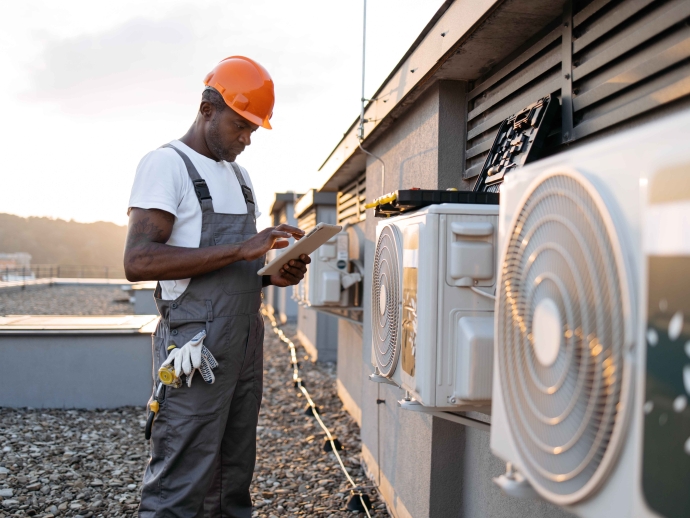Smart HVAC Integration: Creating an Energy-Efficient Smart Home System

As the demand for energy efficiency and comfort in residential spaces continues to rise, integrating smart HVAC systems with home automation technology has become an essential consideration for homeowners. Smart HVAC integration not only enhances indoor comfort but also optimizes energy consumption, leading to significant cost savings. This article explores how smart HVAC systems work, the benefits of integration, and best practices for creating an energy-efficient smart home system.
Understanding Smart HVAC Systems
Smart HVAC systems represent a significant advancement over traditional heating, ventilation, and air conditioning setups. These systems utilize internet-connected devices, sensors, and advanced algorithms to monitor and control indoor climate conditions. Key components of smart HVAC systems include:
-
Smart Thermostats: These devices learn user behavior and preferences over time, adjusting temperature settings automatically based on occupancy patterns. Popular models like Nest and Ecobee offer features such as remote access via smartphone apps, energy usage reports, and integration with other smart home devices.
-
Sensors: Smart sensors monitor various factors such as temperature, humidity, and occupancy. By providing real-time data to the HVAC system, these sensors enable precise control over heating and cooling processes.
-
Zoning Systems: Smart zoning allows homeowners to control temperatures in different areas of the house independently. This is particularly beneficial for larger homes or spaces with varying heating and cooling needs.
Benefits of Smart HVAC Integration
-
Energy Efficiency: One of the most significant advantages of integrating smart HVAC systems is improved energy efficiency. According to the U.S. Department of Energy, programmable thermostats can save homeowners up to 10% on heating and cooling costs annually. Smart systems optimize energy use by adjusting settings based on real-time data from sensors and user preferences.
-
Cost Savings: By reducing energy consumption, smart HVAC systems lead to lower utility bills. Homeowners can expect to see substantial savings over time, especially when combined with energy-efficient appliances and practices.
-
Enhanced Comfort: Smart HVAC integration ensures that indoor environments remain comfortable at all times. With features like adaptive learning and zoning capabilities, these systems provide personalized climate control tailored to individual preferences.
-
Remote Access and Control: Homeowners can monitor and control their HVAC systems from anywhere using smartphone apps or voice commands through smart assistants like Amazon Alexa or Google Assistant. This level of convenience allows users to adjust settings on the go, ensuring optimal comfort upon returning home.
-
Improved Indoor Air Quality: Many smart HVAC systems include advanced filtration options that help maintain healthy indoor air quality by removing allergens, dust, and pollutants from the air.
Best Practices for Creating an Energy-Efficient Smart Home System
-
Assess Your Current HVAC System: Before integrating smart technology, evaluate your existing HVAC system's capabilities and compatibility with smart devices. Consult with a professional to determine if upgrades are necessary for optimal performance.
-
Choose Compatible Smart Devices: Select smart thermostats, sensors, and zoning equipment that are compatible with your existing system. Look for devices that offer seamless integration with other smart home technologies.
-
Install a Smart Thermostat: A smart thermostat serves as the central control unit for your HVAC system. Choose one that offers features such as learning algorithms, remote access, and compatibility with multiple heating and cooling sources.
-
Incorporate Sensors: Install temperature and humidity sensors throughout your home to provide real-time data to your HVAC system. These sensors enable more precise control over climate conditions.
-
Implement Zoning Systems: If your home has multiple levels or distinct areas with varying heating and cooling needs, consider installing a zoning system that allows for independent temperature control in each zone.
-
Integrate with Other Smart Home Devices: Create a cohesive smart home ecosystem by integrating your HVAC system with other devices such as smart lighting, security systems, and appliances. This integration allows for automated routines that enhance comfort and efficiency.
-
Utilize Energy Management Software: Consider using energy management software that provides insights into your home's energy consumption patterns. This data can help you identify areas for improvement and optimize your overall energy use.
-
Regular Maintenance: Ensure that your HVAC system is regularly maintained to operate efficiently. Schedule routine inspections and filter changes to keep your system running smoothly.
Common Pitfalls to Avoid
While integrating a smart HVAC system can yield numerous benefits, there are common pitfalls that homeowners should avoid:
-
Overlooking Compatibility Issues: Not all smart devices are compatible with every HVAC system. Ensure that the devices you choose can integrate seamlessly with your existing setup.
-
Neglecting Professional Installation: While some devices may be DIY-friendly, professional installation ensures that everything is set up correctly for optimal performance.
-
Failing to Monitor Performance: Regularly check the performance of your smart HVAC system to ensure it operates efficiently. Use data analytics tools provided by your devices to track energy usage patterns.
-
Ignoring User Training: Familiarize yourself with how to use your new smart devices effectively. Understanding their features will help you maximize their benefits.
Conclusion
Integrating smart HVAC systems into a home automation setup offers significant advantages in terms of energy efficiency, cost savings, comfort, and convenience. By following best practices for sizing, selecting compatible devices, and avoiding common pitfalls, homeowners can create an energy-efficient smart home environment that meets their needs while promoting sustainability.
As technology continues to evolve, investing in a smart HVAC integration will not only enhance daily living but also contribute positively to reducing overall energy consumption—a crucial step toward building a more sustainable future for our communities.

